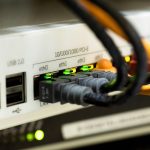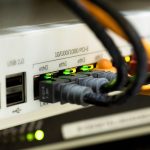To use USB hubs for better device management, choose the right hub based on your device needs and the number of connections required. Keep your workspace organized by consolidating connections and positioning the hub conveniently. Utilize cable management techniques to prevent clutter. Ensure you select a powered hub for high-demand devices and check that your cables are in good condition. By mastering these tips, you'll optimize your setup and enhance overall efficiency. Learn more about maximizing your options.
Table of Contents
Key Takeaways
- Choose a USB hub with multiple ports to connect all necessary devices, reducing clutter and enhancing organization.
- Utilize powered hubs for high-demand devices to ensure consistent power supply and prevent connectivity issues.
- Implement cable management strategies like labeling or color-coding to easily identify and access frequently used cables.
- Position the hub in an accessible location to streamline connections and facilitate quick device management.
- Regularly inspect connections and cables for wear to maintain optimal performance and prevent disruptions.
Understanding USB Hubs: Types and Functions
USB hubs are essential devices that expand the connectivity options for your electronic devices. They come in various types, each serving different functions.
Powered hubs include an external power source, allowing you to connect multiple devices without draining your computer's power. Unpowered hubs, on the other hand, draw power directly from your device and are ideal for fewer gadgets.
Powered hubs provide external power for multiple devices, while unpowered hubs are perfect for connecting fewer gadgets directly from your device.
Additionally, you'll find USB 3.0 hubs, which offer faster data transfer speeds compared to USB 2.0 hubs. Some hubs even include extra features like built-in card readers or Ethernet ports for added functionality.
Understanding these types helps you maximize your device management, ensuring you can connect everything you need without hassle.
Choosing the Right USB Hub for Your Needs
How can you determine which USB hub is best for your setup? Start by assessing how many devices you need to connect.
If you have multiple peripherals like a keyboard, mouse, and external drives, go for a hub with plenty of ports—ideally, more than you think you'll need.
Next, consider the type of USB ports. USB 3.0 or higher offers faster data transfer speeds, which is crucial for high-performance devices.
Also, think about whether you need additional features like charging capabilities or individual power switches for each port.
Finally, ensure the hub is compatible with your operating system.
Setting Up Your USB Hub: Best Practices
When setting up your USB hub, it's crucial to start with the right choice for your devices.
You'll want to organize your cables efficiently to keep your workspace tidy and functional.
Additionally, managing power effectively can help you avoid overload and ensure everything runs smoothly.
Choosing the Right Hub
Choosing the right hub can greatly enhance your productivity and device connectivity.
Start by assessing your needs: how many devices do you want to connect? If you're using multiple peripherals, opt for a hub with several ports.
Consider the types of connections required—USB-A, USB-C, or even HDMI. Speed matters too; look for hubs that support USB 3.0 or higher for faster data transfer.
If portability is important, choose a compact, lightweight model. Don't overlook power delivery—some hubs can charge your devices while in use.
Finally, read reviews to ensure reliability and durability. By selecting a hub that fits your specific requirements, you'll streamline your workspace and enhance your overall efficiency.
Organizing Cables Efficiently
After selecting the right USB hub, the next step involves organizing your cables efficiently to maintain a tidy workspace.
Start by measuring your cable lengths, then consider using cable ties or clips to bundle them together. Label each cable to easily identify what connects to which device.
Try to route cables along the edges of your desk or behind your equipment to minimize clutter. If you have extra length, avoid tangling by using cable sleeves or wraps.
Keep frequently used cables accessible while storing the less-used ones neatly. This way, you can quickly connect devices without fuss.
A well-organized cable setup not only enhances aesthetics but also improves your workflow and reduces the risk of accidental disconnections.
Power Management Tips
To ensure your USB hub operates efficiently, it's essential to manage power effectively from the start.
First, check if your hub is powered or unpowered. A powered hub provides more reliable power to connected devices, reducing the risk of overload.
When connecting multiple devices, prioritize those that require more power, like external hard drives. Avoid daisy-chaining multiple hubs, as this can lead to power loss and connectivity issues.
If your hub has individual power switches for ports, use them to turn off devices that aren't in use, saving energy and extending the lifespan of your hub.
Lastly, keep an eye on the total power output of your hub to prevent overloading and ensure all devices function smoothly.
Organizing Your Workspace With USB Hubs
As you look to streamline your workspace, USB hubs can be a game changer for managing your devices. By consolidating multiple connections into one hub, you can reduce clutter and free up desk space.
Place your hub in a convenient location, like on your desk or mounted under it, so you can easily access USB ports for your keyboard, mouse, and external drives.
Position your USB hub where it's most accessible, whether on your desk or mounted underneath, for effortless connections.
Label cables or use color-coded ties to identify each device quickly, enhancing organization. This setup not only keeps your workspace tidy but also minimizes the time you spend searching for the right connection.
With everything neatly organized, you can focus more on your tasks and less on managing cords and devices.
Maximizing Port Usage: Tips for Efficiency
To make the most of your USB hub, start by prioritizing the devices you use most often.
This way, you'll ensure easy access to essential gadgets while reducing clutter.
Plus, organizing your cable management can enhance both efficiency and aesthetics in your workspace.
Prioritize Essential Devices
When using a USB hub, prioritizing essential devices can significantly enhance your efficiency. Start by identifying the devices you rely on most, like your keyboard, mouse, and external hard drive. Connect these first to ensure they're always accessible.
Next, consider the power requirements of each device; some peripherals may demand more juice, so plug them into dedicated ports if available. Avoid overcrowding your hub with less critical gadgets like USB flash drives or chargers.
Organize Cable Management
Effective cable management is crucial for maximizing the efficiency of your USB hub setup. By organizing your cables, you not only declutter your workspace but also enhance accessibility. Here are some tips to help you manage your cables effectively:
| Tip | Description |
|---|---|
| Use Cable Ties | Bundle cables together to reduce tangles. |
| Label Cables | Clearly mark each cable for easy identification. |
| Route Cables Neatly | Run cables along edges or behind furniture. |
| Opt for Short Cables | Minimize excess length to keep things tidy. |
| Regularly Check Cables | Inspect for wear and replace when needed. |
Implementing these strategies will help you create a streamlined and efficient workspace, making your USB hub setup more functional.
Troubleshooting Common USB Hub Issues
While USB hubs can greatly expand your connectivity options, they can sometimes present issues that disrupt your workflow.
Here are some common problems you might encounter and how to resolve them:
- Device Not Recognized: Ensure the hub is powered and properly connected. Try a different USB port on your computer.
- Slow Data Transfer: Check if the hub supports USB 3.0 or higher. Older hubs might limit speed.
- Overheating: If your hub feels hot, disconnect unused devices and ensure adequate ventilation.
- Inconsistent Power Supply: Use a powered hub for devices that require more power, like external hard drives, to avoid interruptions.
Future-Proofing Your Device Management With USB Hubs
As technology continues to evolve, investing in a quality USB hub can significantly future-proof your device management. By choosing a versatile hub, you ensure compatibility with upcoming devices and enhance your workspace efficiency. With multiple ports, you won't have to worry about limited connectivity, which can lead to frustration.
| Feature | Benefit |
|---|---|
| Multiple Ports | Connect various devices |
| Fast Data Transfer | Save time on transfers |
| Power Delivery | Charge devices quickly |
| Compact Design | Save space on your desk |
| Compatibility | Work with future tech |
Frequently Asked Questions
Can USB Hubs Charge Devices While Data Transfer Occurs Simultaneously?
Yes, USB hubs can charge devices while transferring data simultaneously, as long as they support power delivery. Make sure to check the specifications of your hub for optimal performance with both charging and data transfer.
Are There Limits to the Number of Devices Connected to One Hub?
Yes, there are limits to the number of devices you can connect to one hub. Most hubs support 4 to 10 devices, but it varies by model. Always check the specifications for your specific hub.
Do USB Hubs Work With All Types of USB Devices?
Yes, USB hubs generally work with most USB devices, including keyboards, mice, and storage drives. However, compatibility may vary depending on the hub type and the specific devices you're trying to connect. Always check specifications.
Can USB Hubs Affect the Speed of Data Transfer?
Yes, USB hubs can affect data transfer speed. If too many devices are connected, bandwidth may get divided, slowing down performance. To maintain speed, prioritize which devices you connect and avoid overloading the hub.
Is It Safe to Connect High-Powered Devices to USB Hubs?
Yes, it's generally safe to connect high-powered devices to USB hubs, but always check the hub's power rating. Ensure the hub can handle the total power requirements to prevent overheating or damaging your devices.




